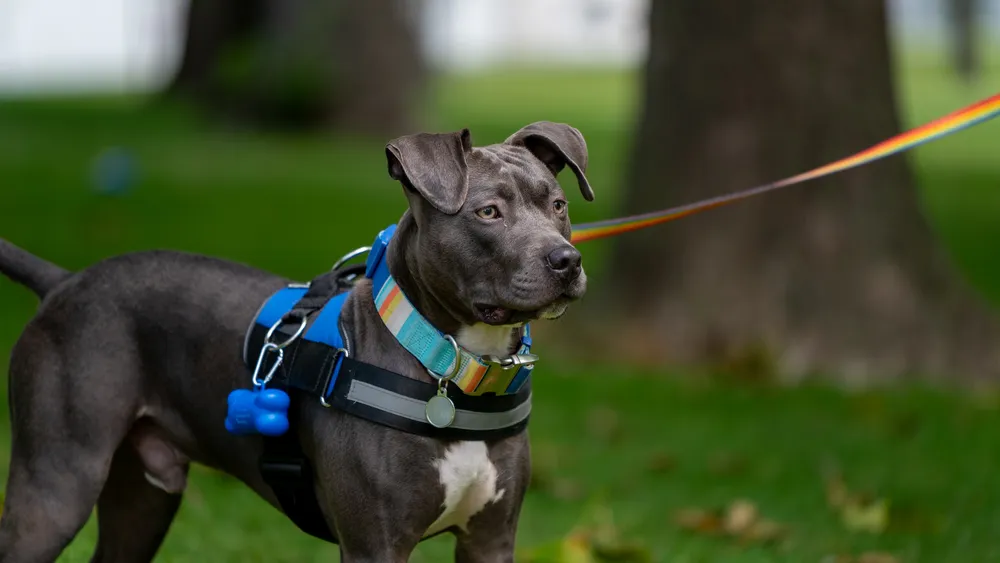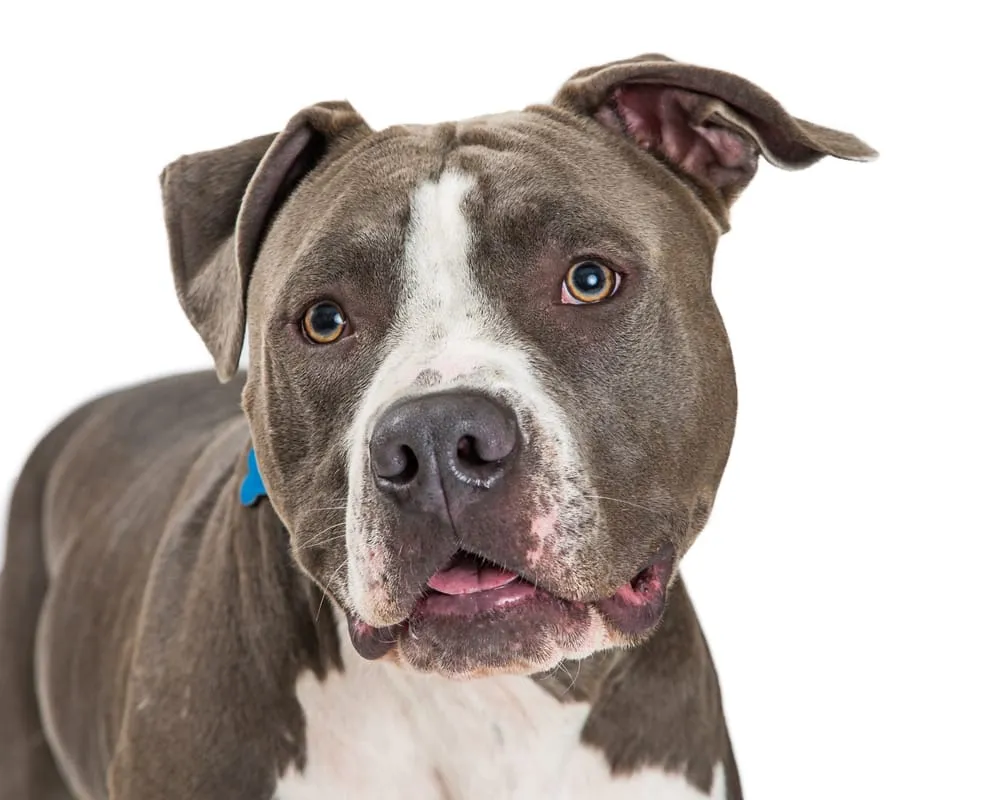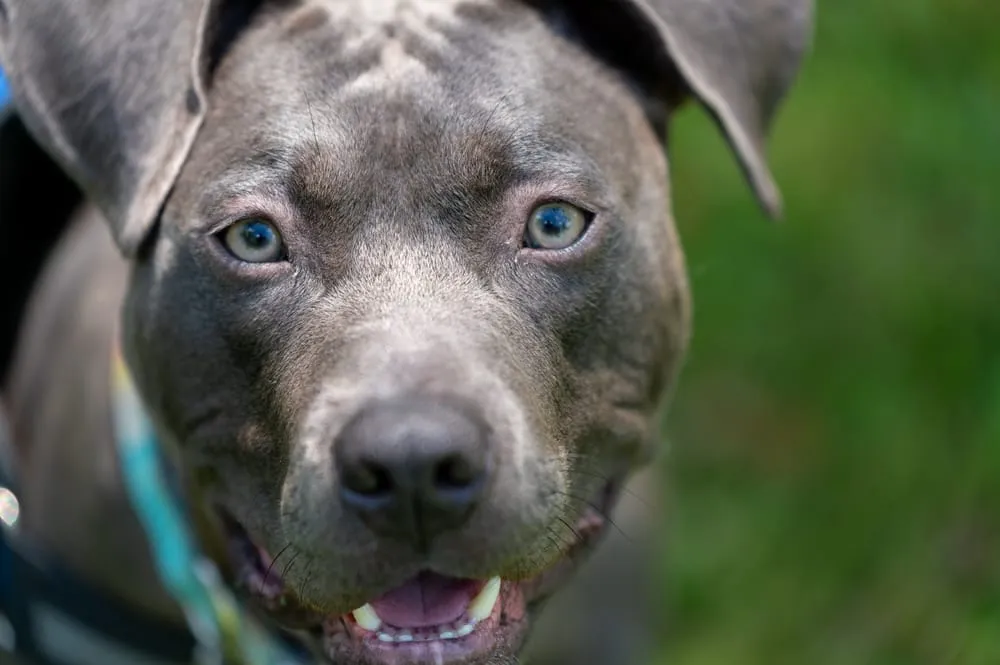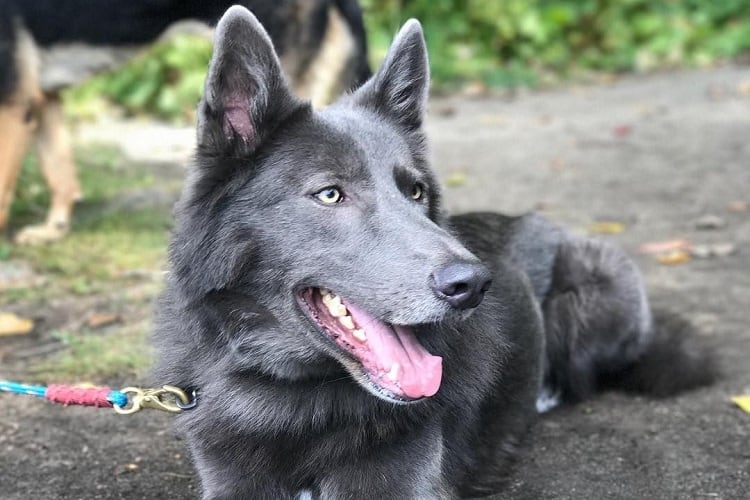What sets a blue nose pitbull apart? These dogs are more than their striking blueish-gray hue; they carry a distinct gene that sets them apart within the pitbull breed. In this guide, we’ll uncover the truth about their characteristics, care requirements, and the reality behind common myths, equipping you with the knowledge needed to appreciate the full picture of blue nose pitbulls.

Key Takeaways
- Blue Nose Pitbulls are not inherently aggressive and the myths regarding their behavior, rarity, and jaw locking are unfounded.
- Caring for a Blue Nose Pitbull requires understanding of their specific health, grooming, exercise, and training needs to ensure a happy and balanced life.
- Legal and insurance considerations for Blue Nose Pitbull owners are vital due to breed-specific legislation and potential insurance challenges.
Understanding the Blue Nose Pitbull
The Blue Nose Pitbull, a term that evokes curiosity and admiration, is often the center of attention in the dog world. But what truly sets these dogs apart? Far from just an eye-catching hue, the “blue nose” is a gateway to a rich history and a set of traits that make this dog breed as intriguing as it is endearing. With roots that intertwine with the broader American Pit Bull Terrier lineage, these canines are a testament to diversity within a breed and the beauty of genetics.
We will now explore the fascinating journey of the Blue Nose Pitbull, uncovering the core of their existence and the factors that contribute to their highly sought-after status.
Origin and Development
The saga of the Blue Nose Pitbull began in the gritty arenas of 19th-century England, where the Old English Bulldogs and English Terriers were crossbred, giving birth to the robust Pitbull Terrier. These early pitbull terriers were more than just gladiators; they served as hunters, herders, and guardians, a testament to their versatility and spirit. As they crossed the Atlantic with British immigrants, they embraced a new identity as the American Pitbull Terrier, a close relative of the American Staffordshire Terrier and the Staffordshire Bull Terrier, and a symbol of resilience and companionship in their new homeland.
The recessive gene that gifts them with their iconic blue hue does not detract from their abilities but adds to their allure, making them a coveted member of the pitbull mosaic.
Unique Traits
The Blue Nose Pitbull is a marvel of nature, a living tapestry woven with genes that paint their world in shades of blue. This genetic twist results in their signature blueish-gray coat and the eponymous nose that captivates onlookers. Contrary to popular belief, not every Blue Nose Pitbull bears the blue nose; some may inherit a black or gray nose, a whimsical reminder of the genetic lottery.
These dogs are more than their color; their broad, muscular build and expressive faces reflect their strength and sociability. Among various dog breeds, the Blue Nose Pitbull, also known as the Blue Pit Bull, is a canvas of nature’s artistry, whether adorned with a solid coat or speckled with charming patterns.
Caring for Your Blue Nose Pitbull

To care for a Blue Nose Pitbull involves an enriching experience filled with love, obligation, and the gratification that comes from nurturing a robust companion. As with any treasure, preserving the health and happiness of these dogs requires knowledge and dedication. From the food that fuels their robust bodies to the grooming that keeps their coats gleaming, every aspect of care is a stepping stone to a fulfilling life.
Understanding their needs for exercise and training is paramount to harmonizing their high energy with the tranquility of home life. We will now examine the fundamental aspects of care that guarantee your Blue Nose Pitbull is not just getting by, but thriving.
Health Considerations
The shimmering coat and solid frame of the Blue Nose Pitbull may conceal a vulnerability to certain health concerns. Allergies, immune deficiencies, and skin conditions linked to their unique pigmentation require a vigilant approach to their well-being. A balanced diet rich in essential fatty acids is the cornerstone of their health, fortifying their skin and coat against the trials of nature.
Regular veterinary check-ups are the compass that guides owners through the landscape of potential health issues, ensuring that any sign of distress is not a whisper but a call to action. Ear and weight monitoring are as much a part of their routine as the affectionate nuzzles they bestow upon their human companions.
Grooming Essentials
The Blue Nose Pitbull’s short, striking coat is a testament to the adage “beauty in simplicity.” Grooming these dogs is less about vanity and more about maintaining their natural elegance. Regular brushing with a suitable brush keeps their coat lustrous and the bond between pet and owner strong. While baths are infrequent, when the time comes, a sensitive skin shampoo ensures that their skin remains as healthy as their spirit.
Nails and ears are not to be overlooked, as trim and tidy nails and clean ears are the hallmarks of a well-groomed Blue Nose Pitbull, reflecting an owner’s care and attention to detail.
Exercise Requirements
The vitality of a Blue Nose Pitbull is a force of nature, a wellspring of energy that demands an outlet. Daily exercise, ranging from vigorous runs to leisurely strolls, is the lifeblood of their physical and mental health. Engaging them in stimulating activities such as agility courses not only keeps their muscles honed but their minds sharp.
The absence of sufficient exercise can lead to a tempest of boredom and frustration, which can manifest in destructive behaviors. To mitigate this, a mix of physical activities and brain games provides a balanced regimen that keeps these active dogs both grounded and content.
Socialization and Training
The heart of a Blue Nose Pitbull is open to the world, eager to embrace all that life has to offer. Early socialization lays the foundation for a dog that is not just confident but compassionate, capable of navigating the social tapestry of life with grace.
Training sessions, when approached with positive reinforcement and patience, harness their intelligence and eagerness to please, transforming raw energy into refined behavior. Mental engagement through challenges and exercises is the key to a well-adjusted Blue Nose Pitbull, ensuring that their potential for camaraderie and companionship is fully realized.
Debunking Blue Nose Pitbull Myths
The Blue Nose Pitbull, like a mythic creature, is often wrapped in tales that distort the truth. These narratives, spun from fear and misunderstanding, paint a picture far removed from the reality of these loving dogs. Now is the moment to separate fact from fiction and expose the reality of Blue Nose Pitbulls, illuminating their genuine disposition and dispelling the long-standing misconceptions that have marred their reputation.
By separating fact from fable, we can appreciate Blue Nose Pitbulls for the affectionate and devoted companions they truly are.
Aggression Myth
The notion that blue nose pitbulls aggressive behavior is inherent is a tapestry woven with threads of misinformation. The color of their coat or the shade of their nose has no bearing on their temperament, which is sculpted by the hands of upbringing and environment. With the right blend of socialization and training, these dogs can be as gentle as a summer breeze.
The myth of “locking jaws” is just that—a myth—with no more truth to it than a fairy tale. Recognizing signs of discomfort and knowing how to manage them is key to fostering a Blue Nose Pitbull’s natural inclination towards friendliness and loyalty.
Rarity and Price Myth
A veil of exclusivity has been cast over the Blue Nose Pitbull due to a misconception about their rarity. The recessive gene responsible for their characteristic blue coloration is not as uncommon as some breeders would have you believe. The illusion of scarcity has been used to inflate prices, but the true value of a Blue Nose Pitbull lies in their health and the responsible practices of their breeders.
It is the dedication to the breed, not the rarity, that should guide the cost of these remarkable dogs.
Choosing the Right Blue Nose Pitbull Puppy

Embarking on the journey to bring a Blue Nose Pitbull puppy into your life is a chapter that begins with choosing the right companion. The decision is not merely about selecting a dog with a charming coat color but finding a puppy whose health and temperament align with your lifestyle and values.
Securing your new friend from a reputable breeder is the cornerstone of this process, ensuring that your future together is built on a foundation of trust and quality. We will now guide you through the process of choosing a Blue Nose Pitbull puppy that will mature into a beloved part of your family.
Identifying a Reputable Breeder
In the quest for a Blue Nose Pitbull puppy, the compass that steers you to a healthy and happy dog is the reputation of the breeder. A reputable breeder is an open book, their knowledge of the breed vast and their breeding practices transparent. These breeders offer not just a puppy but a continued relationship, providing support and advice long after the transaction is complete.
Seeing the living conditions of the puppies and the care the breeder invests is as important as the pedigree papers, reflecting a commitment to the breed that goes beyond the superficial.
Puppy Selection Tips
Selecting a Blue Nose Pitbull puppy is an art, a balance of observing vitality and gauging temperament. A healthy puppy is a wellspring of energy, displaying the playfulness and curiosity that are hallmarks of a well-adjusted canine. Verifying these traits with the breeder, assessing the puppy’s interactions with its littermates, and envisioning its place in your home are crucial to making an informed choice.
This selection process is not just about picking a dog; it’s about welcoming a new soul into your family, one that will bring joy, companionship, and a splash of blue to your life.
Living with a Blue Nose Pitbull
Welcoming a Blue Nose Pitbull into your home is not just about providing shelter but about embracing a new family member with a personality as vibrant as their coat. These dogs bring a unique blend of playfulness, loyalty, and love to the household, thriving in the warmth of human companionship. Understanding the dynamics of integrating a Blue Nose Pitbull into your daily life—from cuddle sessions to playtime—is key to a harmonious coexistence.
We will now delve into the experience of sharing your life with one of these affectionate dogs and how they can enhance the lives of those they interact with.

Family Compatibility
The Blue Nose Pitbull, known for its blue nose pitbull’s temperament, is a loving and playful breed that naturally fits into family life. Some of their key characteristics include:
- Eagerness to bond with both children and adults
- Gentle nature, especially around children
- Loyalty and protectiveness
- Ability to be both a pet and a cherished companion
These qualities make them a great addition to any household.
By fostering their natural inclinations through training and socialization, Blue Nose Pitbulls, including the blue nosed pitbulls, blue nose pit bull, and blue nose pitbull puppies, can embody the very essence of a family dog, offering their hearts and loyalty to those they call their own.
Children and Blue Nose Pitbulls
The historical moniker of ‘nanny dogs’ bestowed upon Blue Nose Pitbulls speaks volumes of their affinity with children. However, their robust stature calls for supervised interactions to ensure safety for both dog and child. Training and socialization play pivotal roles in nurturing a gentle demeanor, while teaching children the right ways to engage with the dog fosters mutual respect.
Through these measures, a Blue Nose Pitbull can become a child’s steadfast guardian and a source of boundless joy.
Interactions with Other Pets
The social tapestry of a Blue Nose Pitbull’s life often includes encounters with other pets. While individual temperament plays a significant role, consistent socialization and positive reinforcement training can pave the way for amicable relationships. Introducing playgroups with familiar dogs and careful selection of compatible companions are essential for peaceful cohabitation.
It is also vital to understand a Blue Nose Pitbull’s body language to preemptively address any signs of conflict and ensure a tranquil multi-pet household.
Legal Considerations for Blue Nose Pitbull Owners
Owning a Blue Nose Pitbull comes with more than just the responsibility of care—it also brings a set of legal considerations that owners must navigate. Breed-specific legislation (BSL) can cast a shadow over the joy of welcoming these dogs into your life, imposing regulations or restrictions that may affect your choice.
Comprehending the legal environment and its consequences is paramount for any responsible Blue Nose Pitbull owner, making certain their cherished companion is not only loved, but legally safeguarded as well.
Breed-Specific Legislation
Breed-specific legislation often targets pit bulls, including Blue Nose Pitbulls, with a broad brush, leading to stringent rules or outright bans in some locales. Despite the challenges and controversies surrounding BSL, it remains a legal reality in many areas, upheld by courts and rarely overturned.
This form of legislation can be a thorn in the side of responsible owners, penalizing well-behaved dogs and their guardians without taking individual behavior into account. Navigating these legal waters requires an understanding of the laws and a commitment to advocating for fair treatment of all dogs, regardless of breed. In this context, staying informed about organizations like the American Kennel Club can be helpful.
Insurance and Liability
The insurance landscape for Blue Nose Pitbull owners can be as tumultuous as the legal one. The breed’s classification as high-risk by some insurers can lead to difficulties in obtaining homeowner’s insurance or hikes in premiums. Liability coverage becomes a shield, protecting owners from the financial fallout should their dog inadvertently cause harm.
While the breed may be painted with a broad brush, securing an endorsement for animal liability is a step towards ensuring peace of mind and financial security in the face of breed-specific challenges.
Summary
The Blue Nose Pitbull is a noble breed, steeped in history and adorned with unique traits that make them as captivating as they are misunderstood. From their origins to their care, from debunking myths to understanding their role in a family, this guide has traversed the multifaceted world of the Blue Nose Pitbull.
Owning one of these affectionate dogs is a responsibility filled with joy, challenges, and legal considerations. Armed with knowledge and understanding, prospective and current owners alike can nurture these loyal companions into the best versions of themselves, ensuring a life shared with a Blue Nose Pitbull is one of mutual respect and boundless love.
Frequently Asked Questions
- How much is a pitbull?
- Purchasing an American Pitbull Terrier puppy typically costs between $500 to $4,500, depending on the breeder's reputation and the puppy's pedigree. You may also find them at shelters for around $600 for a puppy and about $400 for an older dog.
- How much is a blue nose pitbull worth?
- A blue nose pitbull is worth between $1,000 to $3,000, with prices varying based on the breeder and the dog's lineage. It can be more expensive to adopt from a reputable breeder due to the cost of responsible breeding.
- Are blue nose pitbulls less aggressive?
- Yes, blue nose pitbulls are not overly aggressive without cause, but they possess a natural protective instinct and will stand guard over their family if they sense a potential threat. This protective nature, combined with their loyalty, makes them reliable guard dogs.
- What is so special about blue nose pitbulls?
- Blue nose pitbulls are special because of their loving, playful, and loyal temperament, making them great for families and for forming strong bonds with their owners.
- Is it difficult to groom a Blue Nose Pitbull?
- Grooming a Blue Nose Pitbull is not difficult as they have a short coat that requires minimal maintenance. Regular brushing, occasional baths, nail trimming, and dental care are sufficient to keep them well-groomed.






